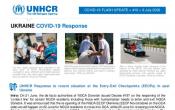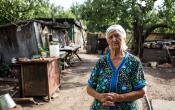Ukraine
For information on UNHCR’s operations in Ukraine prior to 2016, please visit the Regional Office in Ukraine page.
Operation: Ukraine
Location
{"longitude":31,"latitude":49,"zoom_level":5,"iso_codes":"'UKR'"}
By clicking on the icons on the map, additional information is displayed.
The boundaries and names shown and the designations used on this map do not imply official endorsement or acceptance by the United Nations.
Key Figures
| 2019 year-end results | |
| 2,800 | IDPs received primary legal aid while nearly 200 received secondary legal aid |
| 2,700 | IDPs received shelter support |
| 2,200 | asylum-seekers received psychological counselling |
| 2,000 | IDPs with specific needs in GCA benefited from targeted cash assistance |
| 200 | people at risk of statelessness were assisted through national partners to have their nationality confirmed |
| 75% | of refugees had access to primary health care |
| 75% | of refugee children had access to the national education system |
| 2020 planning figures | |
| 75% | of IDP households are living in adequate dwellings |
| 25,000 | IDPs and 2,500 refugees and asylum-seekers receive legal assistance |
| 4,200 | IDPs will receive cash grants and 1,500 IDPs in-kind support |
| 500 | persons with undetermined nationality assisted with confirmation of nationality |
Latest Updates and Related Links
People of Concern
59%
Increase in
2019
2019
| 2019 | 2,454,245 |
| 2018 | 1,544,684 |
| 2017 | 1,844,785 |

[["Refugees",2172],["Asylum-seekers",2430],["IDPs",734000],["Returned refugees",1],["Stateless",35642],["Others of concern",1680000]]
Loading ...
Ukraine
< Back
2019
{"categories":[2015,2016,2017,2018,2019,2020],"budget":[null,42.253913950000005,37.638011739999996,31.083924399999997,27.782351769999995,29.751676449999998],"expenditure":[null,24.601205710000002,21.429359719999997,19.29978754,19.61200023,null]}
{"categories":[2015,2016,2017,2018,2019,2020],"p1":[null,7.1968692,6.774427650000001,6.02906483,4.65644531,5.505890610000001],"p2":[null,0.66575082,0.6325664799999999,0.81396305,0.91078324,0.90883773],"p3":[null,null,null,null,null,null],"p4":[null,34.391293929999996,30.23101761,24.24089652,22.21512322,23.336948109999998]}
{"categories":[2015,2016,2017,2018,2019,2020],"p1":[null,5.4217403,4.82198014,4.3982838300000004,3.92741683,null],"p2":[null,0.0711454,0.31401169,0.45969128000000004,0.55133867,null],"p3":[null,null,null,null,null,null],"p4":[null,19.10832001,16.29336789,14.44181243,15.133244730000001,null]}
Loading ...
CHOOSE A YEAR
- 2016
- 2017
- 2018
- 2019
- 2020
Operational context
Following presidential and parliamentary elections in 2019, UNHCR began working with a range of new government counterparts. However, given the new administration’s focus on security and reform issues, progress on asylum issues was generally not prioritized. The low recognition rate decreased still further, especially for asylum-seekers from Somalia and the Syrian Arab Republic. However, despite these challenges, UNHCR continued to work with refugee communities, civil society and private sector employers to strengthen prospects for integration.Low-intensity armed conflict continued along the contact line in eastern Ukraine, further increasing humanitarian needs of vulnerable people facing ongoing armed conflict, restrictions on movement, mine /unexploded ordnance contamination and continued suspension of social benefits including pensions.
Progress was made on two key issues for IDPs - voting rights and housing. In 2019, the parliament amended the electoral code to give IDPs the right to vote in local elections and the Government also increased funds for an affordable housing program (by approximately $ 19.5 million) thus addressing the needs of some 800 IDP families.
Operational constraints in non-government-controlled areas (NGCA) caused delays in shelter programme implementation. UNHCR continued to adapt by diversifying delivery modalities for shelter interventions. Conversely, in government-controlled areas (GCA), UNHCR’s protection and shelter programmes were implemented smoothly, however the transition of shelter/non-food item (NFI) cluster coordination to government counterparts was delayed due to the change in administration.
Despite expectations that legislation to introduce a statelessness determination procedure would be adopted in 2019, parliament considered it in first reading only late in the year. As a result, UNHCR postponed some capacity-building activities with State authorities and conducted joint advocacy with the humanitarian country team (HCT), particularly on the issue of birth registration for children born in NGCA.
Population trends
In 2019, Ukraine hosted some 4,600 refugees and asylum-seekers (48% refugees, 52% asylum-seekers) with Afghans representing 22% and Syrians 14% of the total population of concern.It was estimated that some 734,000 people were displaced from NGCA, with smaller numbers coming from the Autonomous Republic of Crimea, mainly Crimean Tatars. In total, some 1.7 million people across the country were affected by the conflict.
There were also an estimated 35,600 (5,600 registered) stateless persons in Ukraine. Migrants and ethnic minorities such as Roma, were at heightened risk of statelessness including some 50,000 babies born in NGCA lacking Ukraine-issued birth certificates.
Achievements
- UNHCR supported an organizational development mentorship programme for all national NGO partners in line with the multi-year, multi-partner protection and durable solutions strategy (2018-2022). Of ten participating NGOs, seven successfully completed the programme, resulting in improved management capacities.
- Through a community-based approach to integration, nearly 30 joint refugee, IDP and host community groups were supported.
- UNHCR also engaged with the private sector to facilitate access to employment for people of concern, while providing more intensive language classes.
- UNHCR delivered emergency assistance to people affected by armed conflict on both sides of the contact line, including legal assistance, case management and shelter assistance. To responsibly disengage from the provision of legal assistance, training and referrals were provided to free legal aid centers, who assisted 15% more IDPs than in the previous year.
- UNHCR supported local authorities with construction tools in GCAs, in preparation for disengagement from humanitarian shelter activities.
- The Office implemented a pilot programme, voluntarily relocating 14 families who were living in dangerous areas close to the contact line.
Unmet needs
While UNHCR continued to address the most basic needs of asylum-seekers, additional resources were required for language classes and employment assistance.Moreover, needs in relation to shelter, psychosocial assistance and home-based care were unmet for older persons in remote and insecure areas along the contact line.
UNHCR was also unable to implement shelter interventions for between 8,000 and 9,000 households estimated to have shelter needs in NGCA due to unpredictable humanitarian access and funding.
Operational Environment
Since early 2015, with the adoption of the Minsk Agreement, Ukraine has had a partial ceasefire along a 457 kilometer long line of contact running through Donetsk and Luhansk oblasts in eastern Ukraine. However, violations of the ceasefire occur daily, and the negotiations among parties to the conflict have reached a stalemate. In the first half of 2018, civilian casualties and house destruction have decreased compared to 2017 but tensions remain high.As of 1 July 2018, more than 1.5 million people were registered by the Government as internally displaced. UNHCR’s intervention is part of an inter-agency effort and focuses on four main objectives which are the promotion of: adequate housing for IDPs; social cohesion; legal protection for IDPs to reduce or eliminate various administrative barriers that impact their rights; and community mobilization.
In its 2018-2022 multi-year and multi-partner strategy, UNHCR will adapt its interventions in three distinct operational contexts:
- to provide support to and protection monitoring of people living 20km on both sides of line of contact and provide emergency shelter/NFIs;
- to maintain UNHCR’s humanitarian assistance in non-government controlled areas (NGCA) and facilitate protection of rights;
- to work with partners on durable solutions for IDPs, linking to the growing humanitarian and development nexus in the rest of Ukraine.
Since no major new displacement is expected in 2019, the number of IDPs and IDP-returnees is expected to slightly decrease throughout the year. Many residents in the non-government-controlled areas (NGCA) will continue to travel frequently to government-controlled areas for family reasons and to access pensions and social services.
As of 1 July 2018, Ukraine hosted some 3,200 refugees and some 6,300 asylum-seekers. The majority of them originated from Afghanistan and the Syrian Arab Republic, with more than 50 other countries of origin also represented. In 2019, UNHCR will continue to work with the Government to bring the national asylum system in line with international standards, with a focus on local integration and self-reliance of refugees. Some important legislative initiatives aimed at strengthening the asylum system have been recently adopted, such as providing the same level of rights to unaccompanied children as to Ukrainian orphans.
As of 1 July 2018, UNHCR estimated that more than 35,000 persons in Ukraine are stateless. In 2019, UNHCR will continue to advocate for establishing and implementing an administrative procedure for birth registration that is flexible and responsive to the circumstances of families living in NGCA. This would entail simplifying the documentation requirements, offering registration services close to the line of contact and disseminating information about the administrative procedure. In addition, UNHCR will provide legal assistance to persons at risk of statelessness and advocate for the Government’s establishment of a statelessness determination procedure.
Key Priorities
In 2019, UNHCR will focus on:- leading the protection cluster and its different working groups, and fostering partnerships with IDP communities, international organizations, civil society, and central and local governments;
- protection advocacy, legal assistance, individual protection assistance (using a cash-based interventions where possible), community-based protection activities, such as peaceful coexistence projects and community support initiatives;
- protection monitoring that will largely focus on areas adjacent to the line of contact, but will also encompass areas with large IDP populations;
- conducting shelter repairs for vulnerable families whose house was damaged by the conflict, and responding to any flare-ups in the conflict with the delivery of essential NFIs;
- providing free legal aid to refugees and asylum-seekers regarding the asylum procedure, exercise of civil, social and economic rights, as well as access to public services;
- enhancing practices and strategy in the area of asylum litigation to ensure that judicial review becomes a stronger tool in removing gaps in the asylum procedure; and
- providing training on statelessness to the State Migration Service (SMS), Civil Registration Offices, judges, local administrations, Free Legal Aid Centers and NGOs, as well as legal counselling to stateless persons on obtaining documentation and access to statelessness documents or nationality.
























